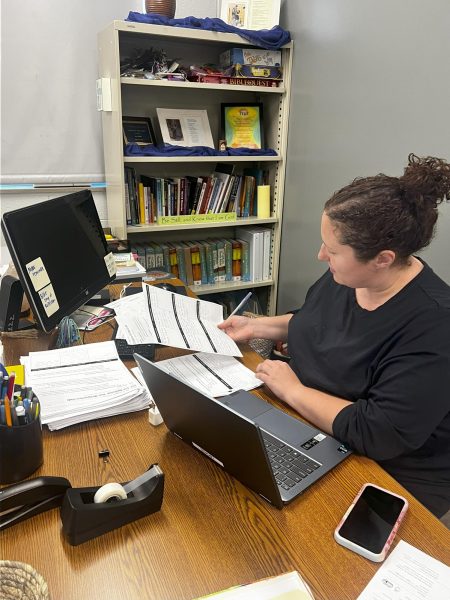Chill out! AC closer than you think
Building crew discusses plans, funding to control school climate
Year after year, during summer school and the beginning and end of the normal school year, teachers and students are burdened with the unfleeting heat that intensifies as each day goes on. Throughout the overbearing humidity of the summer and the scorching dryness of early fall, the school is in desperate need of a cool-down. While the rising temperatures may seem like inevitable signs of a future of overheating in the classroom, the prospect of refreshing air conditioning is not far from reality—and is quite possibly much closer than you think.
“Anybody and everybody that walks into our building, whether its students or Patrons of the Arts, are exposed to uncomfortable and even dangerous conditions, especially those who are compromised with asthma” said Director of Building and Grounds Mr. Steve Burks.
“I feel like my brain is melting,” said English teacher Ms. Jamey Miller. “I have a hard time thinking to create lesson plans. Although the students don’t really notice it, I notice it in myself and my own ability to really work effectively.”
Burks explained that over the span of six years, the Grounds Crew and Administration has been working towards the possibility of school-wide AC. With no help at all from COVID—in which absolutely no in-person work was able to be conducted for nearly a year and a half—this process has been delayed repeatedly.
The COVID mask mandates have heightened the impact of not having AC.
“Masking has made it even harder to focus and [has] created a lack of comfort” said an anonymous student.
In order to make this a palpable project, some important steps must be taken. First, a vetting process must be made by an outside engineer. By recruiting from a qualified firm, a hired engineer will converse with the Grounds Crew in regards to what perspective the school is taking on the condition of AC—basically, what we are looking for in the long run. The engineer will then tour the school and examine all the spaces that are in need of working AC. Finally, they will create a theorized plan of installment so that they can hit the ground running once the plan is confirmed for action.
This, however, is just barely the first half of the process. Even with a plan laid out, the actual proposition must be approved by all the leading school boards. First, Building and Grounds must create a basic installation plan, calculate all of the possible inner-working expenses, and formulate an overall budget plan. They then must vote on the passing of this plan and initiate a presentation of it with the Finance Committee. Next, with the Finance Committee’s knowledge of the idea, using what they call “A Capital Campaign,” they will brainstorm on ways to fund the project. Together, they will collaborate on school-wide fundraising and even outside donations that will benefit the future of this project. Once they determine their means of marketing, they will inform the Board of Trustees on the overarching outlook of this plan. With all this information being considered, the Board will either approve or deny the finalized development of this AC project.
This process alone can take a very long time, and that’s not even considering the phased installation of the actual AC system—which will gradually be completed over a period of time. This will most likely begin in the next year or so, and 73 percent of students agree that the second-floor classrooms should take precedence. While we could still rely on the quick and cheap use of wall fans for oscillation, it is known that they are a short-term solution for a long-lasting problem.
“We try to do our best for the school community,” Mr. Burks said. “Some things have to be immediate, but what we really look for is what’s going to be effective down the road.” Thanks to the diligence of Saint Viator’s Building and Grounds Department, the daily performance of students and faculty will improve with air conditioning.
“Students can focus more on the task at hand than worry about how hot they are,” said social studies teacher Mr. Eric Levin.
So have patience. The installation of air conditioning is not as far from Saint Viator as it seems. Although we think we have the tuition funding and ample space for the project, developing a school-wide AC system is not as easy as feeding a cat; rather, it’s as daunting as taming a lion.
—Additional reporting by Cecelia Whelan
Your donation will support the student journalists of Saint Viator High School. Your contribution will allow us to purchase equipment and cover our annual website hosting costs.






